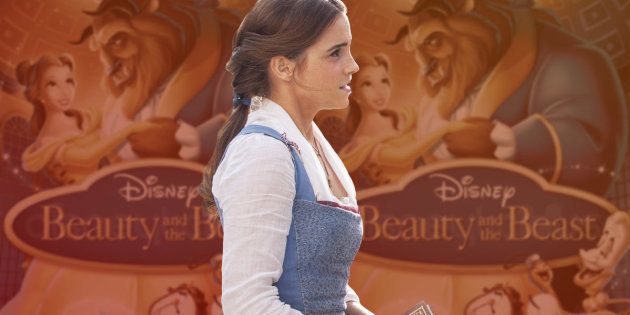
Feminists have long grappled with the contradictory forces that are at play in the 1991 Disney film. On the one hand, Belle maintains a strong sense of self throughout the movie. She has a passion for books. She is defiant in the face of men who want to make decisions for her. She is fiercely loyal to her father. She wants adventure “much more than this provincial life.” On the other hand, she falls in love with a literal animal who initially tells her that she must remain his prisoner forever.
Over the years, the movie has received strong criticism for romanticizing Stockholm Syndrome and sending a message to young girls that it is their job to tame the male “beasts” in their lives. The 2017 version of “Beauty and the Beast” had to contend with this critique before it was even released, with Emma Watson pushing back on it in a February interview with Entertainment Weekly.
“It’s something I really grappled with at the beginning; the kind of Stockholm Syndrome question about this story,” she said. “That’s where a prisoner will take on the characteristics of and fall in love with the captor. Belle actively argues and disagrees with [Beast] constantly. She has none of the characteristics of someone with Stockholm Syndrome because she keeps her independence, she keeps her independence of mind.”
The new film goes to great lengths to demonstrate Belle’s agency in every part of the story, amplifying things that are only subtly touched on in the animated version, and in some cases, creating totally new pieces of plot.
In the 1991 film, Belle is an avid reader. In the 2017 version, she wants to pass that skill and passion along to other girls. (At one point in the film, she attempts to teach a young girl in town to read and is reprimanded by the older male schoolmaster.) And to make it even clearer that Belle’s mind ― not her pretty face ― is her greatest asset, the film turns her into an inventor. She is shown doing the laundry with a contraption she invented herself, sort of a horse-powered precursor to the washing machine.
The movie also makes a point to highlight her romantic agency. Belle rejects the overtures of town cad Gaston even more clearly in 2017 than she did in 1991, telling him flat-out that they could never ever make each other happy and that she will never marry him.
And when it comes to the slow burn romance between Belle and the Beast, the film at least attempts to offer a better explanation for their eventual amorous connection ― and attempts to make it clear that Belle never accepts her fate as a permanent prisoner. She swears to her father that she will escape from the Beast’s castle when she forces him to to trade spots with her. On her first night in the castle, she begins constructing a long chain made of dresses, implying that she might use it in the future to scale her way out of the castle.
Later on, rather than simply justifying Belle and Beast’s romantic bond with one life-saving incident, a few snowballs and a few books (though all of those elements are present in the new movie), the updated version leaves more room for their affection to grow. They discuss Shakespeare and King Arthur. They briefly travel to Paris through an enchanted book and learn about the fate of Belle’s mother ― a character whose existence is ignored in the animated movie. The resulting emotional intimacy bolsters the argument that the Beast has earned Belle’s eventual love.
As an added bonus, the side characters, both women and men, are fleshed out in ways that add to the stakes of the story. The audience is not just invested in Belle and her quest for love, understanding and adventure. We also feel for the other inhabitants of the cursed castle. The family film also highlights (albeit subtly) an openly gay character, Le Fou, and includes two prominent interracial couples ― Lumiere (Ewan McGregor) and Plumette (Gugu Mbatha-Raw), and Madame Garderobe (Audra McDonald) and new character Maestro Cadenza (Stanley Tucci).
Interestingly, despite its shortcomings, “Beauty and the Beast” has always included elements of feminist commentary ― even in its earliest iterations. The fairy tale was first published in 1740 by Gabrielle-Suzanne Barbot de Villeneuve, and then revised and republished in 1756 by Jeanne-Marie Leprince de Beaumont. Even the earliest version of story ― which contains many narrative elements that the 1991 animated film does not ― pushed back on the notion that women must be resigned to a marital partner of their father’s choosing, something that was common practice in 18th-century France.
This theme of ownership over one’s life choices comes through quite strongly in the 1991 film.
